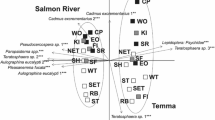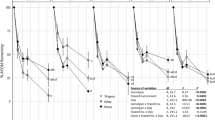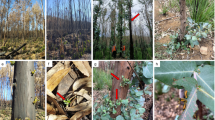Abstract
Genetic variation in foundation trees can influence dependent communities, but little is known about the mechanisms driving these extended genetic effects. We studied the potential chemical drivers of genetic variation in the dependent foliar community of the focal tree Eucalyptus globulus. We focus on the role of cuticular waxes and compare the effects to that of the terpenes, a well-studied group of secondary compounds known to be bioactive in eucalypts. The canopy community was quantified based on the abundance of thirty-nine distinctive arthropod and fungal symptoms on foliar samples collected from canopies of 246 progeny from 13 E. globulus sub-races grown in a common garden trial. Cuticular waxes and foliar terpenes were quantified using gas chromatography - mass spectrometry (GC-MC). A total of 4 of the 13 quantified waxes and 7 of the 16 quantified terpenes were significantly associated with the dependent foliar community. Variation in waxes explained 22.9% of the community variation among sub-races, which was equivalent to that explained by terpenes. In combination, waxes and terpenes explained 35% of the genetic variation among sub-races. Only a small proportion of wax and terpene compounds showing statistically significant differences among sub-races were implicated in community level effects. The few significant waxes have previously shown evidence of divergent selection in E. globulus, which signals that adaptive variation in phenotypic traits may have extended effects. While highlighting the role of the understudied cuticular waxes, this study demonstrates the complexity of factors likely to lead to community genetic effects in foundation trees.

Similar content being viewed by others
References
Abdala-Roberts L, Mooney K (2014) Ecological and evolutionary consequences of plant genotype diversity in a tri-trophic system. Ecology 95:2879–2893
Axelsson E, Iason G, Julkunen-Tiitto R, Whitham T (2015) Host genetics and environment drive divergent responses of two resource sharing gall-formers on Norway spruce: a common garden analysis. PLoS One 10:e0142257
Bailey JK, Wooley SC, Lindroth RL, Whitham TG (2006) Importance of species interactions to community heritability: a genetic basis to trophic-level interactions. Ecol Lett 9:78–85
Baker E (1982) Chemistry and morphology of plant epicuticular waxes. In: Cutler D, Alvin K, Price C (eds) The plant cuticle. Academic Press, London, pp 139–165
Barbour RC, O'Reilly-Wapstra JM, De Little DW, Jordan GJ, Steane DA, Humphreys JR, Bailey JK, Whitham TG, Potts BM (2009) A geographic mosaic of genetic variation within a foundation tree species and its community-level consequences. Ecology 90:1762–1772
Barbour M, Rodriguez-Cabal M, Wu E, Julkunen-Tiitto R, Ritland C, Miscampbell A, Jules E, Crutsinger G (2015) Multiple plant traits shape the genetic basis of herbivore community assembly. Funct Ecol 29:995–1006
Barton K, Valkama E, Vehviläinen H, Ruohomäki K, Knight T, Koricheva J (2015) Additive and non-additive effects of birch genotypic diversity on arthropod herbivory in a long-term field experiment. Oikos 124:697–706
Batish D, Singh H, Kohli R, Kaur S (2008) Eucalyptus essential oil as a natural pesticide. Forest Ecol Manag 256:2166–2174
Bodnaryk R (1992) Leaf epicuticular wax, an antixenotic factor in Brassicaceae that affects the rate and pattern of feeding of flea beetles, Phyllotreta cruciferae (Goeze). Can J Plant Sci 72:1295–1303
Borzak C, Potts B, Davies N, O’Reilly-Wapstra J (2014) Population divergence in the ontogenetic trajectories of foliar terpenes of a Eucalyptus species. Ann Bot-London 115:159–170
Brennan E, Weinbaum S (2001) Effect of epicuticular wax on adhesion of psyllids to glaucous juvenile and glossy adult leaves of Eucalyptus globulus Labillardière. Aust J Entomol 40:270–277
Brunet S, Jackson F, Hoste H (2008) Effects of sainfoin (Onobrychis viciifolia) extract and monomers of condensed tannins on the association of abomasal nematode larvae with fundic explants. Int J Parasitol 38:783–790
Compson Z, Hungate B, Koch G, Hart S, Maestas J, Adams K, Whitham T, Marks J (2015) Closely related tree species differentially influence the transfer of carbon and nitrogen from leaf litter up the aquatic food web. Ecosystems 18:186–201
Compson Z, Hungate B, Whitham T, Meneses N, Busby P, Wojtowicz T, Ford A, Adams K, Marks J (2016) Plant genotype influences aquatic-terrestrial ecosystem linkages through timing and composition of insect emergence. Ecosphere 7:e01331
Cornelissen T, Stiling P (2006) Responses of different herbivore guilds to nutrient addition and natural enemy exclusion. Ecoscience 13:66–74
Crous P, Braun U, Groenewald J (2007) Mycosphaerella is polyphyletic. Stud Mycol 58:1–32
DeWoody J, Viger M, Lakatos F, Tuba K, Taylor G, Smulders M (2013) Insight into the genetic components of community genetics: QTL mapping of insect association in a fast-growing forest tree. PLoS One 8:e79925
Dungey H, Potts B, Whitham T, Li H (2000) Plant genetics affects arthropod community richness and composition: evidence from a synthetic eucalypt hybrid population. Evolution 54:1938–1946
Dutkowski GW, Potts BM (1999) Geographic patterns of genetic variation in Eucalyptus globulus ssp globulus and a revised racial classification. Aust J Bot 47:237–263
Edwards P (1982) Do waxes on juvenile Eucalyptus leaves provide protection from grazing insects? Aust J Ecol 7:347–352
Edwards P, Wanjura W, Brown W (1993) Selective herbivory by Christmas beetles in response to intraspecific variation in Eucalyptus terpenoids. Oecologia 95:551–557
Eigenbrode S (2004) The effects of plant epicuticular waxy blooms on attachment and effectiveness of predatory insects. Arthropod Struct Dev 33:91–102
Eigenbrode S, Espelie K (1995) Effects of plant epicuticular lipids on insect herbivores. Annu Rev Entomol 40:171–194
Eigenbrode S, Jetter R (2002) Attachment to plant surface waxes by an insect predator. Integr Comp Biol 42:1091–1099
Ennis D, Despland E, Chen F, Forgione P, Bauce E (2015) Spruce budworm feeding and oviposition are stimulated by monoterpenes in white spruce epicuticular waxes. Insect Sci 00:1–8
Forkner R, Marquis R, Lill J (2004) Feeny revisited: condensed tannins as anti-herbivore defences in leaf-chewing herbivore communities of Quercus. Ecol Entomol 29:174–187
Gehring C, Flores-Rentería D, Sthultz C, Leonard T, Flores-Rentería L, Whipple A, Whitham T (2014) Plant genetics and interspecific competitive interactions determine ectomycorrhizal fungal community responses to climate change. Mol Ecol 23:1379–1391
Glen M, Smith A, Langrell S, Mohammed C (2007) Development of nested polymerase chain reaction detection of Mycosphaerella spp. and its application to the study of leaf disease in Eucalyptus plantations. Phytopathology 97:132–144
Gosney J, O'Reilly-Wapstra J, Forster L, Barbour R, Iason G, Potts B (2014) Genetic and ontogenetic variation in an endangered tree structures dependent arthropod and fungal communities. PLoS One 9:e114132
Gosney B, Potts B, O'Reilly-Wapstra J, Vaillancourt R, Fitzgerald H, Davies N, Freeman J (2016) Genetic control of cuticular wax compounds in Eucalyptus globulus. New Phytol 209:202–215
Hamilton MG, Williams DR, Tilyard PA, Pinkard EA, Wardlaw TJ, Glen M, Vaillancourt RE, Potts BM (2013) A latitudinal cline in disease resistance of a host tree. Heredity 110:372–379
Heather W (1967a) Leaf characteristics of Eucalyptus Bicostata maiden et al. seedlings affecting the deposition and germination of spores of Pheoseptoria eucalypti (Hansf.). Walker. Aust J Biol Sci 20:1155–1160
Heather W (1967b) Susceptibility of the juvenile leaves of Eucalyptus Bicostata maiden et al. to infection by Pheoseptoria eucalypti (Hansf.). Walker. Aust J Biol Sci 20:769–775
Henery M, Henson M, Wallis I, Stone C, Foley W (2008) Predicting crown damage to Eucalyptus grandis by Paropsis atomaria with direct and indirect measures of leaf composition. Forest Ecol Manag 255:3642–3651
Hersch-Green E, Turley N, Johnson M (2011) Community genetics: what have we accomplished and where should we be going? Philos T R Soc B 366:1453–1460
Jarrold S, Moore D, Potter U, Charnley A (2007) The contribution of surface waxes to pre-penetration growth of an entomopathogenic fungus on host cuticle. Mycol Res 111:240–249
Jones T, Potts B, Vaillancourt R, Davies N (2002) Genetic resistance of Eucalyptus globulus to autumn gum moth defoliation and the role of cuticular waxes. Can J For Res 32:1961–1969
Keith A, Bailey J, Whitham T (2010) A genetic basis to community repeatability and stability. Ecology 91:3398–3406
Korkama-Rajala T, Müller M, Pennanen T (2007) Decomposition and fungi of needle litter from slow- and fast-growing Norway spruce (Picea abies) clones. Microb Ecol 56:76–89
Külheim C, Padovan A, Hefer C, Krause ST, Köllner TG, Myburg AA, Degenhardt J, Foley WJ (2015) The eucalyptus terpene synthase gene family. BMC Genomics 16:1
Kunst L, Samuels A (2003) Biosynthesis and secretion of plant cuticular wax. Prog Lipid Res 42:51–80
Lau M, Keith A, Borrett S, Shuster S, Whitham T (2016) Genotypic variation in foundation species generates network structure that may drive community dynamics and evolution. Ecology 97:733–742
Li H, Madden J, Potts B (1997) Variation in leaf waxes of the Tasmanian Eucalyptus species - I. Subgenus Symphyomyrtus. Biochem Syst Ecol 25:631–657
Loch A, Floyd R (2001) Insect pests of Tasmanian blue gum, Eucalyptus globulus, in south-western Australia: history, current perspectives and future prospects. Austral Ecol 26:458–466
Macauley B, Fox L (1980) Variation in total phenols and condensed tannins in Eucalyptus: leaf phenology and insect grazing. Aust J Ecol 5:31–35
Macias F, Galindo J, Galindo J (2007) Evolution and current status of ecological phytochemistry. Phytochemistry 68:2917–2936
Maddox G, Root R (1987) Resistance to 16 diverse species of herbivorous insects within a population of goldenrod, Solidago altissima: genetic variation and heritability. Oecologia 72:8–14
Maldonado-Lopez Y, Cuevas-Reyes P, González-Rodríguez A, Pérez-López G, Acosta-Gómez C, Oyama K (2015) Relationships among plant genetics, phytochemistry and herbivory patterns in Quercus castanea across a fragmented landscape. Ecol Res 30:133–143
Matsuki M, Foley W, Floyd R (2011) Role of volatile and non-volatile plant secondary metabolites in host tree selection by christmas beetles. J Chem Ecol 37:286–300
O'Reilly-Wapstra J, McArthur C, Potts B (2004) Linking plant genotype, plant defensive chemistry and mammal browsing in a Eucalyptus species. Funct Ecol 18:677–684
O'Reilly-Wapstra J, Freeman J, Davies N, Vaillancourt R, Fitzgerald H, Potts B (2011) Quantitative trait loci for foliar terpenes in a global eucalypt species. Tree Genet Genomes 7:485–498
Oyedeji A, Ekundayo O, Olawore O, Adeniyi B, Koenig W (1999) Antimicrobial activity of the essential oils of five Eucalyptus species growing in Nigeria. Fitoterapia 70:526–528
Park R, Keane P (1982) Leaf diseases of Eucalyptus associated with Mycosphaerella species. Transactions of the British Mycol Soc 79:101–115
Pérez-López G, González-Rodríguez A, Oyama K, Cuevas-Reyes P (2016) Effects of plant hybridization on the structure and composition of a highly rich community of cynipid gall wasps: the case of the oak hybrid complex Quercus magnoliifolia x Quercus resinosa in Mexico. Biodivers Conserv 25:633–651
Post-Beittenmiller D (1996) Biochemistry and molecular biology of wax production in plants. Annu Rev Plant Physiol 47:405–430
R Core Team (2013) R: A language and environment for statistical computing. R Foundation for Statistical Computing, Vienna, Austria. http://www.R-project.org/
Rapely LP, Allen GR, Potts BM (2004) Susceptibility of Eucalyptus globulus to Mnesampela privata defoliation in relation to a specific foliar wax compound. Chemoecology 14:157–163
Reisige K, Gorzelanny C, Daniels U, Moerschbacher B (2006) The C28 aldehyde octacosanal is a morphogenetically active component involved in host plant recognition and infection structure differentiation in the wheat stem rust fungus. Physiol Mol Plant P 68:33–40
Riederer M, Schreiber L (1995) Waxes: the transport barriers of plant cuticles. In: Hamilton R (ed) Waxes: chemistry, molecular biology and functions, vol 6. The Oily Press, Dundee, pp 130–156
Robinson KM, Ingvarsson PK, Jansson S, Albrectsen BR, Kliebenstein DJ (2012) Genetic variation in functional traits influences arthropod community composition in aspen (Populus tremula L.). PLoS One 7:e37679
Rönnberg-Wästljung A, Åhman I, Glynn C, Widenfalk O (2006) Quantitative trait loci for resistance to herbivores in willow: field experiments with varying soils and climates. Entomol Exp Appl 118:163–174
Samuels L, Kunst L, Jetter R (2008) Sealing plant surfaces: cuticular wax formation by epidermal cells. Annu Rev Plant Biol 59:683–707
Schweitzer J, Madritch M, Bailey J, LeRoy C, Fischer D, Rehill B, Lindroth R, Hagerman A, Wooley S, Hart S (2008) From genes to ecosystems: the genetic basis of condensed tannins and their role in nutrient regulation in a Populus model system. Ecosystems 11:1005–1020
Sinclair F, Stone G, Nicholls J, Cavers S, Gibbs M, Butterill P, Wagner S, Ducousso A, Gerber S, Petit R (2015) Impacts of local adaptation of forest trees on associations with herbivorous insects: implications for adaptive forest management. Evol Appl 8:972–987
Smith A (2006) The development of strategies for the management and research of foliar pathogens on eucalypt plantations: Using Mycosphaerella as a case study. PhD Thesis, University of Tasmania. http://eprints.utas.edu.au/378/. Accessed 3 May 2017
Smith AH, Pinkard EA, Stone C, Battaglia M, Mohammed CL (2005) Precision and accuracy of pest and pathogen damage assessment in young eucalypt plantations. Environ Monit Assess 111:243–256
Smith D, Bailey J, Shuster S, Whitham T (2011) A geographic mosaic of trophic interactions and selection: trees, aphids and birds. J Evol Biol 24:422–429
Steinbauer M, Clarke A, Paterson S (1998) Changes in eucalypt architecture and the foraging behaviour and development of Amorbus obscuricornis (Hemiptera: Coreidae). Bull Entomol Res 88:641–651
Steinbauer M, Schiestl F, Davies N (2004) Monoterpenes and epicuticular waxes help female autumn gum moth differentiate between waxy and glossy Eucalyptus and leaves of different ages. J Chem Ecol 30:1117–1142
Stone C, Bacon P (1994) Relationships among moisture stress, insect herbivory, foliar cineole content and the growth of river red gum Eucalyptus camaldulensis. J Appl Ecol 31:604–612
Tack A, Roslin T (2011) The relative importance of host-plant genetic diversity in structuring the associated herbivore community. Ecology 92:1594–1604
Tucker D, Wallis I, Bolton J, Marsh K, Rosser A, Brereton I, Nicolle D, Foley W (2010) A metabolomic approach to identifying chemical mediators of mammal–plant interactions. J Chem Ecol 36:727–735
Uppalapati S, Ishiga Y, Doraiswamy V, Bedair M, Mittal S, Chen J, Nakashima J, Tang Y, Tadege M, Ratet P (2012) Loss of abaxial leaf epicuticular wax in Medicago truncatula irg1/palm1 mutants results in reduced spore differentiation of anthracnose and nonhost rust pathogens. Plant Cell 24:353–370
Velmala S, Rajala T, Haapanen M, Taylor A, Pennanen T (2013) Genetic host-tree effects on the ectomycorrhizal community and root characteristics of Norway spruce. Mycorrhiza 23:21–33
Whitham T, Bailey J, Schweitzer J, Shuster S, Bangert R, Leroy C, Lonsdorf E, Allan G, DiFazio S, Potts B, Fischer D, Gehring C, Lindroth R, Marks J, Hart S, Wimp G, Wooley S (2006) A framework for community and ecosystem genetics: from genes to ecosystems. Nat Rev Genet 7:510–523
Whitham T, Gehring C, Lamit L, Wojtowicz T, Evans L, Keith A, Smith D (2012) Community specificity: life and afterlife effects of genes. Trends Plant Sci 17:271–281
Wimp G, Martinsen G, Floate K, Bangert R, Whitham T (2005) Plant genetic determinants of arthropod community structure and diversity. Evolution 59:61–69
Wimp G, Wooley S, Bangert R, Young W, Martinsen G, Keim P, Rehill B, Lindroth R, Whitham T (2007) Plant genetics predicts intra-annual variation in phytochemistry and arthropod community structure. Mol Ecol 16:5057–5069
Yarnes C, Boecklen W, Salminen J (2008) No simple sum: seasonal variation in tannin phenotypes and leaf-miners in hybrid oaks. Chemoecology 18:39–51
Yeats T, Rose J (2013) The formation and function of plant cuticles. Plant Physiol 163:5–20
Zinkgraf M, Meneses N, Whitham T, Allan G (2016) Genetic variation in NIN1 and C/VIF1 genes is significantly associated with Populus angustifolia resistance to a galling herbivore, Pemphigus betae. J Insect Physiol 84:50–59
Acknowledgements
We thank Paul Tilyard, and Justin Bloomfield for collection of the samples involved in this study. Tim Wardlaw and Caroline Mohammad for help in the identification of symptoms. Peter Harrison for symptom assessment. Noel Davies and Hugh Fitzgerald for the analysis and quantification of the chemistry involved in the study, and Jules Freeman and René Vaillancourt for discussion and contribution to early wax studies. Forestry Tasmania and Forico Pty Limited for access to the trials. This study is part of a PhD undertaken by Benjamin Gosney, supported by an International Postgraduate Scholarship provided by the University of Tasmania and funded by the Australian Government. Data collection was funded by Australian Research Council Discovery (DP0773686) and Linkage (LP120200380 in partnership with Greening Australia) grants.
Author information
Authors and Affiliations
Corresponding author
Electronic supplementary material
ESM 1
(PDF 2768 kb)
Rights and permissions
About this article
Cite this article
Gosney, B., O’Reilly-Wapstra, J., Forster, L. et al. The Extended Community-Level Effects of Genetic Variation in Foliar Wax Chemistry in the Forest Tree Eucalyptus globulus . J Chem Ecol 43, 532–542 (2017). https://doi.org/10.1007/s10886-017-0849-5
Received:
Revised:
Accepted:
Published:
Issue Date:
DOI: https://doi.org/10.1007/s10886-017-0849-5




